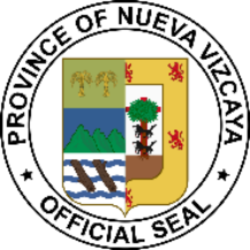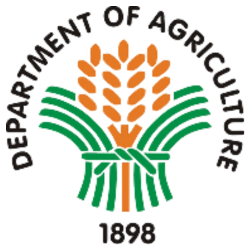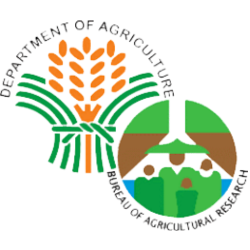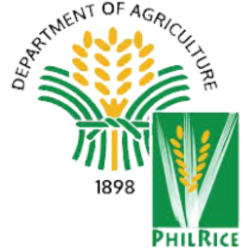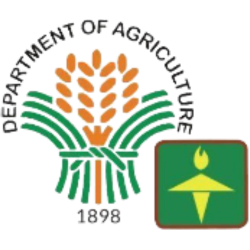NVSU-DA Partnership in Rice Seed Production and Promotion
The project partnership with the Department of Agriculture mobilized NVSU in promoting technologies and commercial use of certified seeds of improved inbred rice varieties by farmers in Nueva Vizcaya. In the scheme NVSU engaged in seed production, channeled a portion of the harvest to seed recipients from selected municipalities, monitored rice production and extended technical assistance to farmers, and sold the rest of the seeds through the Nueva Vizcaya Seed Growers and Marketing Cooperative.
NVSU set aside a 4.0-hectare area and produced for two seasons a total of 674 bags of certified seeds of improved inbred rice varieties preferred by farmers. The project channeled 200 bags through the Municipal Agriculture Offices of Aritao, Bayombong, Solano, and Villaverde, Nueva Vizcaya. Under an agreement, beneficiaries pay with 60 kg good seeds they produce from the 40 kg certified seeds they received from the project. The endeavor effectively promoted use of certified seeds and provided opportunities for technical sharing of inputs during monitoring, strengthening of linkage with partners, and generating income for the university from sales of certified seeds. Recorded yield showed a range of 3.75-6.30 tons ha-1 and a net income range of Php35,000-86,000 per ha for Bayombong, while 4.19-7.5 tons ha-1 with a net income range of Php42,500-110,000 per ha for Aritao, suggesting a relatively good harvest and farm income for users of NVSU-produced certified seeds.
A microproject was also set-up as a strategic approach for promoting certified seed production through an entrepreneurship scheme involving a senior graduating agriculture student. The student entrepreneur successfully produced certified seeds from half a hectare with technology applications from seed preparation to post-harvest processing. The microproject yielded a total of 52 bags (40 kg per bag) sold for Php62,500.00 and generated a 93% return on cash expense (ROCE). The success of the student led to a degree Bachelor in Agricultural Technology
Keywords: rice, seed
Citation (APA): Sapigao, K. M. A. & Espiritu, O. P. (2014). Ground acapulco (Cassia alata) seeds as potential dewormer for native chicken. NVSU Research Journal, 1(1), 5-13.
Vitrification of Swamp Buffalo Oocytes
The study was conducted to examine the role of various factors (presence/absence of cumulus cells, meiotic stage, oocyte source, pre-equilibration time, warming condition, method of vitrification) to establish the optimum condition for vitrification of buffalo oocytes. Survival was based on the morphological normality post-warming, completion of first meiosis and penetrability post fertilization in vitro.
In Experiment 1, survival of germinal vesicles (GV) stage cumulus-oocyte-complexes (COCs) or denuded oocytes was significantly lower than the control regardless of pre-equilibration time used except when using 10-minute exposure time. The maturation rate of vitrified oocytes was lower compared to the control. In Experiment 2, the survival of vitrified/warmed GV oocytes had no difference with the control regardless of the warming conditions used although the maturation rate was lower. Among treatments, descending trehalose concentration and exposure time appeared better than direct warming and stepwise warming with descending trehalose concentration with same exposure time. In Experiment 3, vitrification of oocytes at GV or metaphase II (M2) stage showed no difference in terms of survival and fertilizability but use of the cryotop method appeared better than the minimum drop size (MDS) method. In Experiment 4, oocyte source had no effect on the survival and fertilizability of vitrified/warmed M2 stage oocytes. In Experiment 5, the cleavage and blastocyst formation rate of vitrified/warmed oocytes was lower than the control.
The results showed that buffalo GV and M2 stage oocytes can survive vitrification either by MDS or cryotop method, complete first meiotic division, be fertilized and produce embryos although to limited extent.
Keywords: oocytes, vitrification, survival, maturation, fertilization, embryos
Citation (APA): Ocampo, M. B., Ocampo, L. C., & Soriano, R. P. (2014). Vitrification of swamp buffalo oocytes. NVSU Research Journal, 1(2), 15-24.
Enhancing Theses Recording and Monitoring Using a Customized Database Management System (DBMS)
A Theses Management and Monitoring System (TMMS) was designed and implemented to enhance the recording and monitoring of undergraduate theses at the Research and Development-Management Information Systems Office of the Nueva Vizcaya State University, Bayombong, Nueva Vizcaya, Philippines. The TMMS is a customized Database Management System (DBMS) using Microsoft Access.
The TMMS was able to solve the basic problems encountered with manual and keyed-in recording since it allowed users to easily access and generate the needed information by just a few clicks and key in on a computer.
The results showed that buffalo GV and M2 stage oocytes can survive vitrification either by MDS or cryotop method, complete first meiotic division, be fertilized and produce embryos although to limited extent.
Keywords: database management system
Citation (APA): Avellanoza, E. M., Nanglegan, M. J. A., Hernandez, M. A., & Angeles, C. A. (2014). Enhancing theses recording and monitoring using a customized Database Management System (DBMS). NVSU Research Journal, 1(2), 25-33.
On-farm Evaluation of Chinese Kale (Brassica Oleracia Bailey) Grown With Organic Fertilizers in Kasibu, Nueva Vizcaya
On-farm evaluation for Chinese kale adaptability, productivity and quality was done by conducting a field experiment involving variety and organic fertilizer inputs as interventions in Kasibu, Nueva Vizcaya from September to December 2013.
The growth and yield performance of Kailaan and Gai Lohn were similar.
Results indicated the superiority of organic over that of inorganic fertilizer. Chicken manure (CM), vermicompost (VC) and processed chicken manure (PCM) enhanced the growth and consequently, the yield of Chinese kale.
In terms of quality, the color of both varieties were similarly rated as “like very much” and in terms of taste, both were “like moderately.” Kailaan and Gai Lohn were rated as “not bitter”.
Based on the findings of the study, Kailaan and Gai Lohn are suitable varieties of Chinese kale for planting in Kasibu, Nueva Vizcaya. For high yield and good quality Chinese kale, organic fertilizers such as CM, VC, and PCM should be applied instead of inorganic fertilizer.
Keywords: Chinese kale, organic
Citation (APA): Calub, N. P., Torres, L. G., & Yago, J. I. (2014). On-farm evaluation of Chinese kale (Brassica alboglabra Bailey) grown with organic fertilizers in Kasibu, Nueva Vizcaya. NVSU Research Journal, 1(2), 34-40.
Pre-service Teachers’ Teaching Effectiveness: the Nueva Vizcaya State University Experience
In the world of teaching, teachers are constantly amazed by the ingenuity of their teaching; they learn to be imaginative and inventive; they make a difference in the lives of their pupils, and they get so much unreserved affection, respect and love in return. Thus, teachers must guarantee to continue cultivating their learners, to uncover their potentials and to mold them as well-rounded citizens. This study ascertained the teaching effectiveness of pre-service teachers of the Nueva Vizcaya State University, Philippines. As a descriptive-correlation study, this paper acknowledged that the domains of teaching effectiveness which include the pre-service teacher’s personality, lesson planning, content, teaching methods, classroom management, and questioning skills were associated to their demographic variables. Single pre-service teachers give their full attention to their practice teaching thus manifesting a higher level of teaching effectiveness in their usage of teaching methods. On the other hand, married pre-service teachers have bigger responsibilities other than teaching hence, their display of satisfactory teaching effectiveness. When the cooperating school is situated near the university, the pre-service teachers only exhibited a satisfactory teaching effectiveness in learning content and managing classrooms while those who were deployed to distant schools demonstrated a remarkable teaching effectiveness. Pre-service teachers who were assigned to far-off districts and schools were motivated to be highly prim and proper and considerate so as to be good models to their learners. Generally, pre-service teachers who were deployed to districts that are far from the University were enthused to be highly communicative in asking questions and in stimulating the higher order thinking skills of their learners.
Keywords: pre-service teachers, teaching effectiveness, teaching method, content, classroom management, questioning skills, lesson planning, teacher personality
Citation (APA): Tominez, B. A. & Dela Cruz, L. M. (2014). Pre-service teachers’ teaching effectiveness: The Nueva Vizcaya State University experience. NVSU Research Journal, 1(2), 41-52.
Allelopathic Effects of Two Hedgerow Species on the Survival and Early Growth of Corn (Zea Mays L.)
Experiments in the laboratory and nursery were undertaken to test the allelopathic effects of Jatropha curcas and Gliricidia sepium on Zea mays L. The allelopathic effects of the two hedgerow species were assessed in terms of survival, germination, early shoot and root growth, and biomass of corn.
Fresh leaves of J. curcas and G. sepium were used to produce extracts in different concentrations that served as treatments for the laboratory experiment. Soils were collected in an agroforestry area located in Bangan Hill. These were mixed with dried leaves from the two species separately to produce different potting mixture that served as treatments for the nursery experiment.
Significant differences were observed among the treatments in the laboratory experiments. There were allelopathic effects from the prepared extracts on the germination survival, early shoot and root growth, and biomass of corn. The higher the concentration of the leaf extract from both species, the higher is the degree of observed effects on survival and early growth of corn.
Significant differences among treatments were also observed in the nursery experiments. Survival percentages of corn planted in the high amount of shredded J. curcas leaves in the potting mixture were affected, while corn in potting mixture of any amount of shredded G. sepium leaves were not affected. Delay of germination by 2-3 days was observed in corn potted in mixture with shredded J. curcas leaves while a delay of 1-2 days was observed in corn potted in mixture with shredded G. sepium leaves. Shoot length and biomass of corn planted in the mixture with less quantity of shredded J. curcas leaves were higher compared to corn planted in the mixture with higher quantity of leaves. On the other hand, shoot growth of corns planted in any amount of shredded G. sepium leaves in the potting mixture did not significantly vary. For the biomass, corn planted with fewer amounts of shredded G. sepium leaves in the mixture is significantly higher.
Keywords: database management system, allelopathy, hedgerow
Citation (APA): Manee, M. & Rodriguez, R. S. (2014). Allelopathic Effects of Two Hedgerow Species in the Survival and Early Growth of Corn (Zea mays L.). NVSU Research Journal, 1(2), 53-69.
A Rapid Floral Diversity-elevation Survey Along the Maddiangat Trail of Mt. Palali, Nueva Vizcaya
Mt. Palali is one of the standouts and economically critical landforms in the province of Nueva Vizcaya. It is feared that without proper understanding of biodiversity therein, resources may be exploited for short-term economic returns. To generate viable information for decision-makers, the researchers conducted a rapid survey of Palali’s floristic composition and diversity with respect to the ecological elevation and terrain of the mountain. Incidence data was recorded from 37 stations established along the major trail loacated at Barangay Maddiangat, Quezon. Alpha diversity indices (Shannon H’, Simpson’s D, Pielou’s J’) were computed and cluster analysis done to describe species, vegetation types and community diversity.
Ninety-seven (97) species including nine morphotypes in 208 encounters were counted. The most frequently observed were Shoreapolysperma (14 observation points) Lithocarpusllanosii (12), Shoreacontorta (11) Saurarialatibractea (10) Sarcandraglabra (9) and Caralliabrachniata, Cinnamomummercadoi, (8), Pityrogrammacalomelanos, Shoreapalosapis, Tristaniopsisdecorticata, all with 8 encounters. Species diversity is very high (H’ = 4.229). as well as variety of dominant species (1-D = 63.400) and distribution is highly even (J’ = 0.924).
Six (6) observation points were without forest trees, which were either converted farm lots or open areas dominated by grasses. At (~300-500 masl) Palalis’s plant community were influenced by farming and timber harvesting, while at (~1350 to ~1,717 masl) is dominated by Vaccinium, Rhododendron, Symplocos and Homolanthus. At ~1450 masl, Astronia, Melastoma, Nephenthes, Dacrycarpus become more visibly abundant. Numerous rattan species are found as well in the upper montane and sub-alpine mossy forest of Mt. Palali.
Visual observation was supported by ordination of observation points, yielding four communities. Community 1 dominated by Cinnamomummercadoi, Shorea palosapis, Shorea polysperma, Lithocarpus lanosii and Sarcandra glabra, has the most contiguous span, ranging from 655 to 857 masl. Estimated crown cover is 60%-80% along the trail allowing smaller plants to receive sunlight without much interference and attenuation while Community 2 forms the lower elevations of Palali (360 to 567 masl). Ficus species are found scattered and where shade is present, ferns like Kilob (Dicranopterislinearis) and Pneumatopterissp can be found. Community 3 are scattered somewhere between 644 to 1,601 masl. The composition is mixed, but visibly abundant are rattans, Syzygium, Astronia and Saurarialatibractea. Lastly, Community 4 is comprised of the subalpine from 1519 to the summit.
Here, the vegetation and structure are very different from the rest as it is dominated by Vaccinium, Rhododendron, Melastoma. Leptospermum and numerous mosses. These observations denote that Mt. Palaliis very diverse not only in terms of species, but also in the variety of ecosystems / plant communities found along its terrain.
Keywords: soil interpolation method, soil mapping, IDW, kriging, spline
Citation (APA): Manuel, R. P. & Pascua, R. L. (2014). A rapid floral diversity-elevation survey along the Maddiangat Trail of Mt. Palali, Nueva Vizcaya. NVSU Research Journal, 1(2), 70-76.
Ecological Sustainability of Land Uses in the Barobbob Watershed
The study was conducted to assess the carbon stocks and estimate soil loss as indicators of ecological sustainability of major land uses in the watershed, and carbon footprints of farmer-occupants in the Barobbob Watershed at Bayombong, Nueva Vizcaya.
The area was subdivided into agroecological zones based on slopes, which was used as land mapping units. Assessment of sustainability was based on the ecological soundness of major land uses using tree species diversity, soil macro fauna, bacterial and fungal count, fertility level and soil loss as indicators.
The natural forest was ecologically sound due to:(1) potential soil loss was far below the soil loss tolerance; (2) diverse forest tree species; (3) bacterial and fungal populations were abundant; (4) good fertility status as nitrogen and potassium were present in sufficient amounts. However, the agroforestry areas failed to be ecologically sustainable because of higher soil loss than the soil loss tolerance and low fertility status.
The natural forest with a mean diversity index of 1.48 had a substantial amount of carbon with an average value of 323.19 tons C ha-1 while the agroforestry with a mean diversity index of 1.19 obtained an average carbon of 157.23 tons C ha-1./p>
Carbon footprints of farmer-occupants in the watershed ranged from 1.34 to 3.27 t CO2 ha-1. The firewood contributed the largest share. High income farmer-occupants emitted higher carbon than low-income farmers.
Keywords: ecological sustainability, land uses, carbon stocks, soil loss tolerance, soil macrofauna, bacterial and carbon footprints
Citation (APA): Pablo, A. D. & Perez, F. O. (2014). Ecological sustainability of land uses in the Barobbob watershed. NVSU Research Journal, 1(2), 77-89.





















